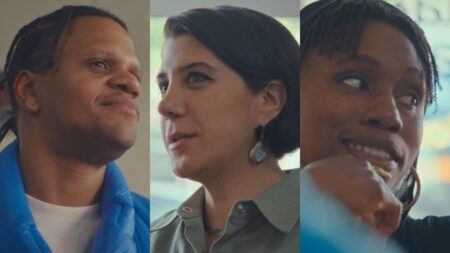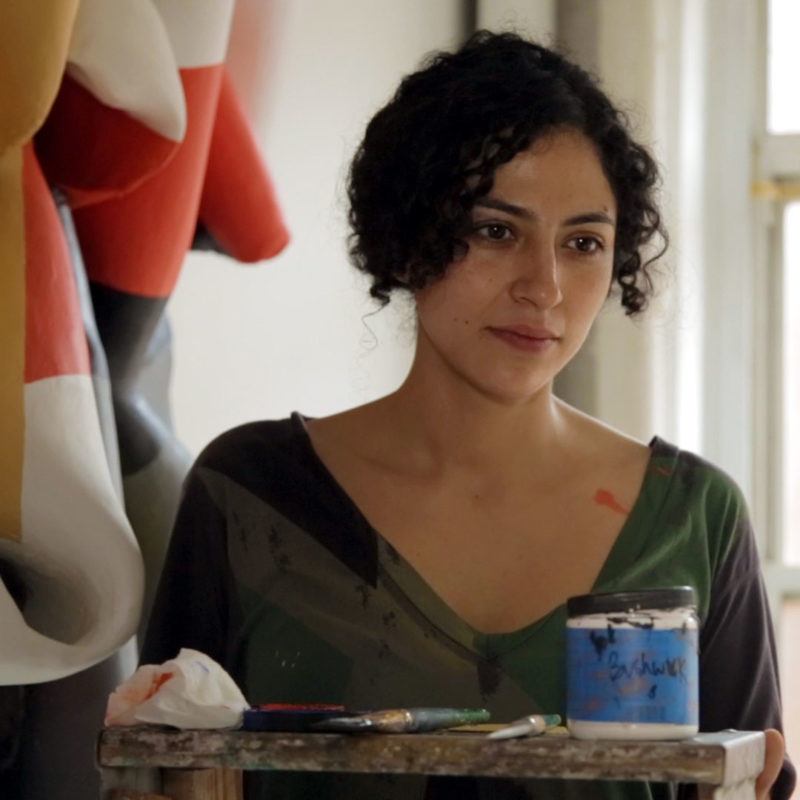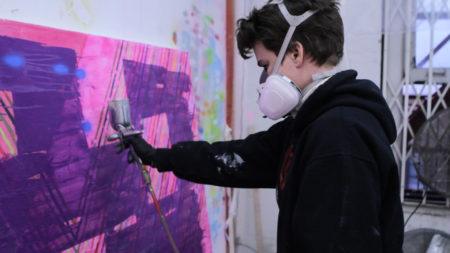Continue playing
(Time remaining: )
Play from beginning
Continue playing "{{ controller.videos[controller.getVideo(controller.currentVideo)].segmentParentTitle}}"
{{controller.videos[controller.getVideo(controller.currentVideo)].title}} has ended.
Marela Zacarías Goes Big & Goes Home
What does an artist bring to a homecoming? Working in her Bedford–Stuyvesant studio, artist Marela Zacarías undertakes Red Meander (2014), a commission by the Art in Embassies program for the U.S. Consulate in Monterrey, Mexico. Zacarías enlists the help of a team of eight assistants to create the fifty-eight foot long by eleven foot tall work—her largest painted sculpture to date—over the course of nine months. Comprising twenty handmade sections that fit together like a puzzle, each component is made of sanded joint compound over window screen affixed to wood supports.
The undulating surface of Red Meander is emblazoned in intricate patterns of sixty-seven acrylic colors inspired by Mayan patterns, specifically textiles from Chiapas and Oaxaca. “Hidden in plain sight in the clothing and decorations, these symbols survived colonization and modern times,” says Zacarías, “Weaving became a form of cultural resistance that was passed down from mothers to daughters for centuries.” Growing up in Mexico City, the artist also recalls visiting Diego Rivera’s murals (1929–30, 1935) in the National Palace.
Having spent a decade painting over thirty murals ranging in size from ten to over a hundred feet long, with this project Zacarías realizes a major achievement: exhibiting her work back home in Mexico, for the first time, and as a permanent installation in an historic building. Recognizing both the problems and promise of the U.S. immigration system, Zacarías suggests that “for me to do this piece, it was like really meeting myself kind of in the middle of it. I want to connect to the people that are going through this transition.”
Featured in this film is additional artwork by Diego Rivera and music by Los Amparito & Los Músicos de José.
Credits
Art21 New York Close Up Created & Produced by: Wesley Miller & Nick Ravich. Producer & Editor: Rafael Salazar & Ava Wiland. Cinematography: Rafael Salazar, Iria Gómez Concheiro & Ava Wiland. Sound: Iria Gómez Concheiro & Ava Wiland. Associate Producer: Ian Forster. Design & Graphics: CRUX Design & Open. Artwork: Marela Zacarías & Diego Rivera. Music: Los Amparito & Los Músicos de José. Thanks: Art In Embassies, U.S. Department of State, Atelier 4, Camille Benton, David Foarde, Katherine Garcia, Celia Herrera Lavín, Jorge Herrera Lavín, Gregory Kuykendall Jr., Christian Maychack, Caroline Maxwell, Weston Pew, Michael Roopenian, U.S. Consulate General Monterrey, Sean William Sweeney, Zaira Zacarías Bustos. An Art21 Workshop Production. © Art21, Inc. 2014. All rights reserved.
Art21 New York Close Up is supported, in part, by The Lambent Foundation; the New York City Department of Cultural Affairs in partnership with the City Council; The Andy Warhol Foundation for the Visual Arts; and by individual contributors.
Closed captionsAvailable in English, German, Romanian, Italian, Japanese, Korean, Chinese, Italian
Through the Art21 Translation Project, multilingual audiences from around the globe can contribute translations, making Art21 films more accessible worldwide. Translate this video now.
Interested in showing this film in an exhibition or public screening? To license this video please visit Licensing & Reproduction.
Marela Zacarías was born in 1978 in Mexico City, Mexico, and currently lives and works between New York and Mexico City. A muralist painter for more than ten years, Zacarías wanted to bring walls into three-dimensional space. Her resulting wall-mounted painted sculptures twist and turn in unruly ways, built from window screens, joint compound, and polymer before being painted in bold, geometric, abstract patterns. Explaining her shift away from figurative painting, Zacarías says, “I feel like abstraction really allows for the story to be filtered and to come out in a different way in which people can see it or not see it at all.”
Supersized
Julie Mehretu
Preview
El Anatsui
“…it was like really meeting myself kind of in the middle of it. I want to connect to the people that are going through this transition.”
Marela Zacarías




